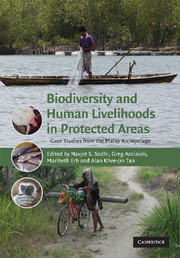Book contents
- Frontmatter
- Contents
- List of contributors
- Acknowledgements
- 1 General introduction
- Part I Conservation needs and priorities
- Part II Conservation with and against people(s)
- 11 Introduction to Part II
- 12 Collaboration, conservation, and community: a conversation between Suraya Afiff and Celia Lowe
- 13 Hands off, hands on: communities and the management of national parks in Indonesia
- 14 Conservation and conflict in Komodo National Park
- 15 Another way to live: developing a programme for local people around Tanjung Puting National Park, Central Kalimantan
- 16 For the people or for the trees? A case study of violence and conservation in Ruteng Nature Recreation Park
- 17 Seas of discontent: conflicting knowledge paradigms within Indonesia's marine environmental arena
- 18 Strategy and subjectivity in co-management of the Lore Lindu National Park (Central Sulawesi, Indonesia)
- 19 Indigenous peoples and parks in Malaysia: issues and questions
- 20 Protecting Chek Jawa: the politics of conservation and memory at the edge of a nation
- 21 Integrating conservation and community participation in protected-area development in Brunei Darussalam
- 22 Conclusion to Part II
- Part III Legal and governance frameworks for conservation
- 29 General conclusion
- Index
- References
11 - Introduction to Part II
from Part II - Conservation with and against people(s)
Published online by Cambridge University Press: 12 November 2009
- Frontmatter
- Contents
- List of contributors
- Acknowledgements
- 1 General introduction
- Part I Conservation needs and priorities
- Part II Conservation with and against people(s)
- 11 Introduction to Part II
- 12 Collaboration, conservation, and community: a conversation between Suraya Afiff and Celia Lowe
- 13 Hands off, hands on: communities and the management of national parks in Indonesia
- 14 Conservation and conflict in Komodo National Park
- 15 Another way to live: developing a programme for local people around Tanjung Puting National Park, Central Kalimantan
- 16 For the people or for the trees? A case study of violence and conservation in Ruteng Nature Recreation Park
- 17 Seas of discontent: conflicting knowledge paradigms within Indonesia's marine environmental arena
- 18 Strategy and subjectivity in co-management of the Lore Lindu National Park (Central Sulawesi, Indonesia)
- 19 Indigenous peoples and parks in Malaysia: issues and questions
- 20 Protecting Chek Jawa: the politics of conservation and memory at the edge of a nation
- 21 Integrating conservation and community participation in protected-area development in Brunei Darussalam
- 22 Conclusion to Part II
- Part III Legal and governance frameworks for conservation
- 29 General conclusion
- Index
- References
Summary
All of the chapters in this part attempt to present the perspectives of local communities in the Malay Archipelago whose members have been confronted with a paradigm of conservation that is often alien to them. Unlike the other parts presenting views from conservation biologists and lawyers, this part presents the perspectives of mainly anthropologists, who have worked closely with local communities in an attempt to understand both their knowledge of their environment and the social institutions that form the framework of their practices in regard to it. While conservation biologists tend to look at the problem of conservation from the planetary perspective of maximizing biodiversity, including avoiding species extinction, and lawyers tend to look at the problems of the legal frameworks put in place to safeguard protected areas, hence often concentrating upon the national context of these laws (though in the context of global conventions and frameworks), anthropologists are concerned with the ecological and political-cultural consequences of the global and the national at the level of the local.
Some environmental ethicists and conservation biologists have recently advocated a return to a more exclusionary stand against local communities living in the vicinity of protected areas, what Wilshusen et al. (2002) refer to as a ‘resurgent protection paradigm’ (cf. Rolston 1996). In contrast, all of the chapters in this part call for more nuanced understandings of local situations that take into account the history of the peoples who live in or near protected areas, what their relationships with their environment have been, and the political and economic relations that have made their environments of interest to the global and national communities.
Information
- Type
- Chapter
- Information
- Biodiversity and Human Livelihoods in Protected AreasCase Studies from the Malay Archipelago, pp. 143 - 152Publisher: Cambridge University PressPrint publication year: 2007
